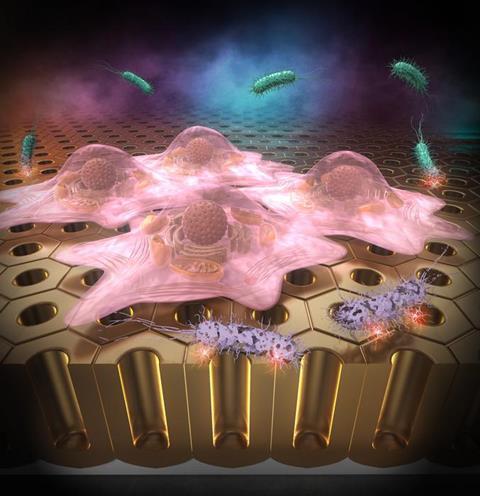Researchers from Tokyo Metropolitan University have created nanostructured alumina surfaces which are strongly antibacterial but can be used to culture cells. They found that anodic porous alumina (APA) surfaces prepared using electrochemistry in concentrated sulfuric acid had unprecedented resistance to bacterial growth, but did not hamper cell cultures.

The team’s technology promises to have a big impact on regenerative medicine, where high quality cell cultures without bacterial contamination may be produced without antibiotics.
Surfaces that resist bacterial contamination play a vital role in public health and our daily lives. While this might be achieved with powerful antibiotics and chemicals, this entails a negative environmental impact, health hazards, as well as the potential emergence of dangerous, antibiotic-resistant strains. We need alternative ways of controlling the spread of bacterial pathogens.
Cicada wings
This is where nanostructured surfaces come in. In the early 2010s, it was shown that the naturally formed nanostructure on the wings of cicada and dragonfly wings can resist bacterial contamination. The structures damage the cell membrane of bacterial cells and prevent them from spreading. Thus, scientists have been on the lookout for ways to cheaply manufacture artificial surfaces which might achieve the same effect.
READ MORE: Infection ability of viruses reduced by 96% using mechanical methods
READ MORE: Silicon spikes skewer 96% of virus particles
A team of researchers led by Professor Takashi Yanagishita from Tokyo Metropolitan University have been exploring the use of anodic porous alumina (APA). When polished aluminum surfaces are dipped in an electrochemical cell under certain conditions, the surface is coated with a well-ordered array of porous pillars of alumina (aluminum oxide). These needle-like pillars are just the right size to be deadly to bacteria, making the surfaces strongly antibacterial.
Perfecting the recipe
Now, the team have perfected their recipe, finding that APA surfaces prepared in concentrated sulfuric acid have antibacterial properties which significantly outperform existing surfaces. Crucially, they discovered that the surfaces were not hazardous to biological cells cultured on them. In normal cell cultures, antibiotics may be added to the culture medium to prevent the incidence of bacterial contaminants. This has the major drawback of being useless against antibiotic resistant bacteria; in fact, their overuse might again lead to the emergence of more resistant strains. This is not the case with APA surfaces. Cultures may be safely carried out without antibiotic additives.
The team’s discovery is good news for regenerative medicine, where cells are cultured in the lab before being introduced to a patient to treat tissue and organ damage. Any bacterial intruder in the cells may have dire consequences for sick patients: this usually entails specialized and costly sterile environments. The team believe that their new substrates might enable antibiotic-free cell culture in a wider range of settings, potentially revolutionizing the scale at which patients may be treated, as well as how we do scientific experiments.
This work was partially supported by JSPS KAKENHI Grant Number JP24K01219.







No comments yet